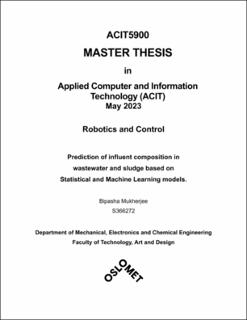| dc.description.abstract | For the optimized operation of a wastewater resource recycle facility (WWRF), it is essential to consider significant disturbances such as fluctuations in the influent flow rate and wastewater compositions. The online monitoring of influent characteristics is limited by scarce instrumentation and high costs. This study demonstrated influent composition prediction of two different wastewater treatment plants (WWTPs), with wastewater and sludge treatment process. Data-driven models (statistical models used for time series analysis/ Machine learning model) have been developed using HIAS wastewater treatment process and VEAS sludge treatment process data to predict the influent compositions. In this work, statistical models for time series analysis such as ARIMA (Autoregressive Integrated Moving Average) and SARIMAX (Seasonal Autoregressive Integrated Moving Average with Exogenous input), Linear regression, Lasso, Ridge regression and different machine learning algorithms such as Random Forest (RF), Decision Tree (DT), Support Vector Regression (SVR) and Artificial Neural Network (ANN) were examined and compared. These models were developed to detect inlet phosphate (PO4), and inlet soluble chemical oxygen demand(sCOD) in wastewater inlet organic acid in sludge, which served as output variables. In both processes, Linear regression, Ridge regression and Neural Network consistently demonstrated the best performance for evaluation estimation as evidenced by the lowest values of Root Mean Square Error (RMSE), and the highest coefficient of determination (R2). SARIMAX exhibited acceptable results with R2 as 0.95 in organic acid prediction modeling. In contrast, ARIMA and SARIMAX algorithms in Hias datasets did not meet the requirements because of the complex and nonlinear structure of the dataset issue. This study offers an efficient method for forecasting the quality of wastewater and sludge influents, which can be advantageous for process control and thereby contributing to the zero-pollution objective of the European Green Deal and to the European Missions such as one on ‘Restoring our ocean and waters by 2030’. | en_US |
